VOTERS WANT UNION WITH GERMANY
Saarbruecken, Saarland, Germany · January 13, 1935
On this date in 1935 Germans held a plebiscite in the only part of Germany that remained under foreign occupation following their country’s defeat in World War I—the Saar region, or Saarland in German. The wealth of its coal deposits and their large-scale industrial exploitation, coupled with its location on the border between France and Germany (see map), made for Saarland’s unique history. The first shots of the Franco-Prussian War of 1870–71 were fired here. During the course of that war, Saarland became part of the German Empire. In 1920 Saarland was occupied by Great Britain and France, first under the provisions of the 1919 Treaty of Versailles, then under the terms of a 15‑year‑long League of Nations mandate. The autonomous territory was officially known as “The Territory of the Saar Basin” (Le Territoire du Bassin de la Sarre). The territory’s coalfields were ceded to France.
For two years, ever since his rise to power as chancellor of Germany in January 1933, Adolf Hitler had campaigned to bring Saarland’s 800,000 residents back into the Reich’s fold just as the original 15‑year League mandate neared expiration. A considerable number of political opponents of Hitler’s National Socialism had found asylum in Saarland, and as a result anti-Nazi groups, including the Communists, agitated against reunification. However, most Saarlanders were ethnically German with anti-French sentiments, so the League mandate was widely unpopular.
With a 98 percent voter turnout, the result was that the overwhelming majority who cast their ballots—almost 91 percent—voted to rejoin Germany. Fewer than nine percent voted to retain the status quo, while a third option of joining France received less than one percent of the vote. Four days later, on January 17, 1935, the territory’s reunion was approved by the League Council. Their asylum ended, many Saarland refugees began heading for England.
Following the plebiscite Hitler announced that Germany “had no further territorial demands to make of France”—a farcical statement as history proved five years later. On March 1, 1935, Germany re-integrated the region into the German Reich. Hitler’s foreign policy was rewarded with France and Great Britain acknowledging a de facto revision of the Versailles Treaty.
![]()
Saarland’s Reintegration into the German Reich, 1935
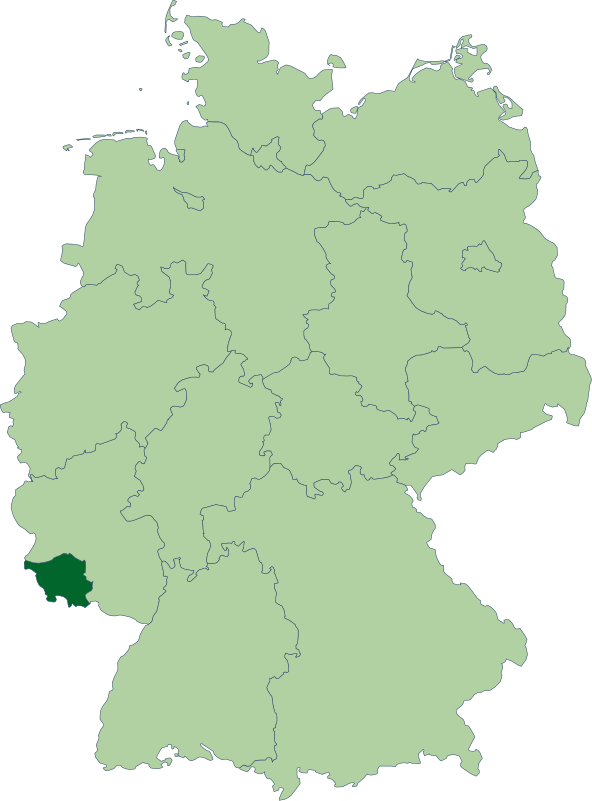 |
Above: Location of the Saarland (dark green) in modern Germany. Prior to its creation as the Territory of the Saar Basin by the League of Nations after World War I, the Saarland (or simply “the Saar,” as it is frequently referred to) did not exist as a unified entity. Until then, some parts of the Saar had belonged to the Prussian Rhine Province while other parts belonged to the Bavarian Palatinate. During the Nazi period it became known as Saar-Palatinate (Saarpfalz) and in 1942 as Westmark (meaning Western Boundary of the Reich; Austria was renamed Ostmark following the 1938 Anschluss, or union with Germany). After World War II, Saarland was made a United Nations protectorate under French occupation and administration. France returned control of the region to the West German government in 1957.
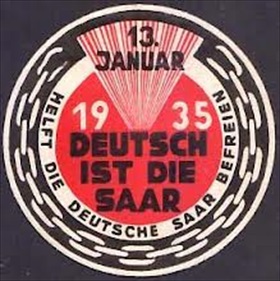 | 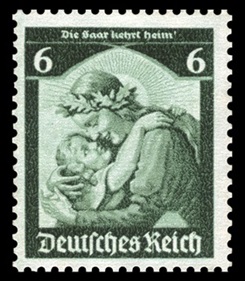 |
Left: Nazi Party campaign piece from 1934–35 agitated for the return of the Saarland to the Fatherland. The inscription reads: “Help free the German Saar.”
![]()
Right: First-day issue (January 16, 1934) days after the first anniversary of the Saar plebiscite. The inscription along the top reads, “The Saar comes home!”
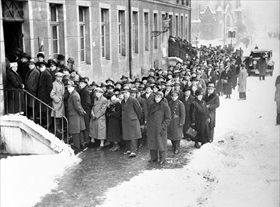 | 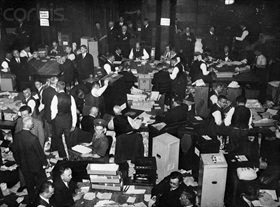 |
Left: Voters line up at a polling place in Saarland to cast their vote in the January 13, 1935, plebiscite. Twenty-two months earlier, in the November 13, 1932, elections to the 51‑seat Consultative Council in the Territory of the Saar Basin, the Catholic Center Party held the largest number of seats, at 17, followed by the Communist Party, with 12 seats. The Socialists and the Nazi Party trailed, each with eight seats. On July 5, 1933, as a condition of the conclusion of a Concordat between the Vatican and Nazi Germany, the Center Party dissolved itself.
![]()
Right: Neutral observers from many countries were employed in counting ballots, which the Saar’s inhabitants cast in the 1935 plebiscite that decided the territory was to rejoin the German Reich. The photo shows the counters at work as the ballots began arriving from various communities.
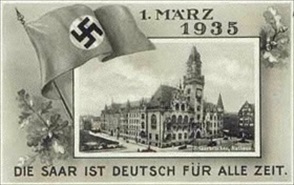 | 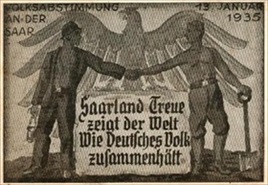 |
Above: German postcard on the left celebrates the March 1, 1935, reintegration of the Saar region into the German Reich. The image on the postcard is that of the city hall in Saarbruecken, the capital city of Saarland. The text of the postcard on the right reads (in English): “Saarland’s devotedness shows the world how the German people stick together.”
Germans Celebrating Return of Saarland to Germany, January 1935
![]()

 History buffs, there is good news! The Daily Chronicles of World War II is now available as an ebook for $4.99 on Amazon.com. Containing a year’s worth of dated entries from this website, the ebook brings the story of this tumultuous era to life in a compelling, authoritative, and succinct manner. Featuring inventive navigation aids, the ebook enables readers to instantly move forward or backward by month and date to different dated entries. Simple and elegant! Click
History buffs, there is good news! The Daily Chronicles of World War II is now available as an ebook for $4.99 on Amazon.com. Containing a year’s worth of dated entries from this website, the ebook brings the story of this tumultuous era to life in a compelling, authoritative, and succinct manner. Featuring inventive navigation aids, the ebook enables readers to instantly move forward or backward by month and date to different dated entries. Simple and elegant! Click 











